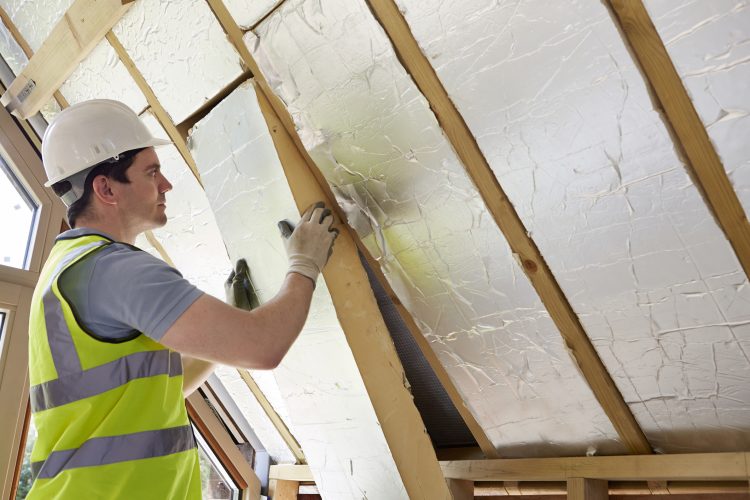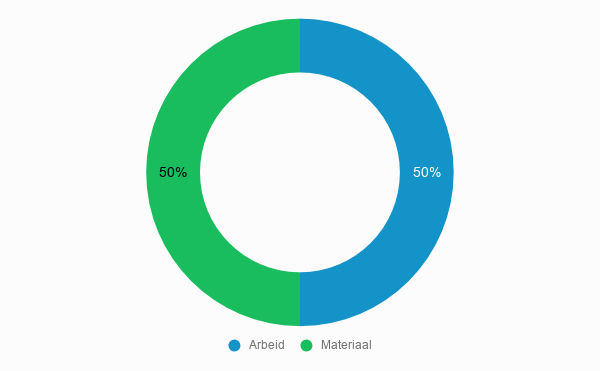Want to have your home insulated? Then the attic may not be the first option you think of. Yet insulating your attic is a smart option. After all, you will reduce your energy costs and increase the value of your home. Read all about insulating your attic here, from costs to materials and benefits to installing the insulation.
What will it cost to insulate an attic?
If you insulate your attic, you have the choice of insulating the attic floor or the roof. See below for an indication of the prices per type of house.
Insulating the attic floor
Is the attic not heated and does not need to be? Then you can insulate the attic floor or loft. An attic floor can be fitted with insulation blankets, boards, foam or beads, depending on the construction of the floor. The exact cost of floor insulation depends on the type of insulation material you choose. The table below gives an indication of the cost if you have your attic floor insulated by a specialist.
| Type of house | Average cost |
|---|---|
| Tween house (30 m²) | £ 900 – £ 1.200 |
| Corner house / semi-detached house (40 m²) | £ 1,200 – £ 1,600 |
| Detached house (60 m²) | £ 1,800 – £ 2,400 |
Roof insulation
Do you prefer a heated attic? Then insulate the roof. A pitched roof can be insulated in two ways: from the outside or from the inside of the roof. For both methods of roof insulation, the table below gives an indication of the costs per dwelling type, including installation by a specialist.
| Type of dwelling | Isolation through the inside of the roof | Isolation through the outside of the roof |
|---|---|---|
| Tween dwelling (50 m²) | £ 3,000 – £ 3,750 | £ 3,500 – £ 4.250 |
| Corner house / semi-detached house (65 m²) | £ 3,900 – £ 4,900 | £ 4,500 – £ 5,500 |
| Detached house (100 m²) | £ 6,000 – £ 7.500 | £ 7,000 – £ 8,500 |
Find the best specialist for your project and get free quotes.
Start

Price structure for an attic insulation

Subsidy options when insulating an attic
From the government, a subsidy is available for private homeowners who have insulation measures carried out in a home built before 1 January 2019.
The subsidy for projects carried out from 2 April 2022 is £4 per m2 for attic floor insulation and £15 per m2 for roof insulation. These amounts will remain unchanged in 2023. Please note, you may apply for a subsidy for either roof insulation or attic/floor insulation. Not for both. Do you combine one of these insulation measures with another measure not mentioned here or with a heat pump, solar boiler or connection to a heat network? Then the above amounts double.
There are some conditions you have to meet. For instance, you must be living in the house yourself and you may not carry out the insulation measures yourself. Have any second measure carried out no later than 24 months after the first measure to be entitled to the doubling. The insulation material used must also meet certain conditions. All conditions for subsidies can be found on the RVO website.
In addition to national subsidies, some municipalities, water boards and provinces also offer local subsidies for insulation. Check whether your region has any subsidy schemes via the Energy Subsidy Guide.
Do you want to know more? Read all about subsidy options in our subsidy insulation article.
Why should you insulate your attic?
Insulating your attic can be quite an investment. So why should you insulate your attic anyway? The main reason why people insulate houses is, of course, to save on energy costs. Less cold penetrates the house in winter and heat stays in better. As a result, the heating system does not have to work as hard. It also stays cooler for longer in summer.
Do you opt for roof insulation so you can heat the attic? Because insulation helps maintain the temperature in the attic better, it increases the living comfort of your home. You also create more living space as the attic can be used as a bedroom, study or hobby room. The value of your house rises along with it. In addition to heat insulation, insulation measures also provide sound insulation. By insulating your attic, you will also be less bothered by noises from outside.

What is the best insulation material for an attic?
Insulating boards or blankets are used to install roof insulation. You cut these to size so that they form an unbroken insulating layer. Filling or taping any gaps or seams prevents weak spots. For floors, boards and blankets are used as well as foam and beads, depending on the construction of the floor.
Which insulation material to use depends on your living situation, how insulating it should be and what other characteristics you consider important. Each insulation material has properties that make it a better or worse match for your preferences.
Do you prefer insulation material that is 100% recyclable and environmentally friendly? Natural materials like flax, hemp and wood fibre, or mineral wool like glass wool and rock wool are good choices.
You can also select insulation materials with sound insulation in mind. Are you looking for the highest insulation value? With materials like PIR, a thin layer of insulation is enough to be highly insulating.
In short, consider what your main requirements are and compare insulation materials. Do you find it difficult to determine this yourself? A specialist can help you by advising you on the choice of material based on your living situation and wishes.
How to insulate your attic?
As mentioned earlier, you can insulate both the attic floor and the roof. To give you an idea of what is involved, we will explain the global step-by-step plan of a specialist.
Insulating the attic floor
How the attic floor is insulated depends on the construction of the floorboards: whether they are made of wood or concrete. If the floors are made of wood, there is space between the floor joists (called rafters), which becomes visible when the floorboards are removed. This space is filled with insulation material. Think blankets, pearls or foam.
First of all, it is checked whether ceiling battens are already present. If not, these are installed. Next, a vapour-proof foil is placed on these battens to prevent moisture problems. Finally, the insulation material is added. The floorboards can then be put back in place.
Is the storey floor made of concrete or another solid material? Then a gap is not naturally present. Compressible insulation material can then be applied to the bare floor together with a vapour-proof foil, after which it is finished with floor covering. Another option is to lay a slatted floor that mimics the wooden construction. In both cases, the floor rises slightly.
Insulating the pitched roof from the outside
In order to lay the insulation material via the outside of the roof, the existing roof covering and the underlying wooden battens must first be removed from the roof. Any old insulation material is also removed.
Next, the old vapour control membrane on the roof is replaced, after which the new insulation material can be laid on the roof. This insulation material is cut to size so that the boards will soon be tightly fitted together. This prevents thermal bridges and weak spots in your insulation. Usually, insulation boards with a tongue and groove system are used. This way they fit together perfectly without gaps between the boards.
The seams of the insulation boards are additionally taped to make the insulation windproof. A new waterproof foil is also placed over the insulation material so that the insulation material is water- and airtight. This prevents possible draughts or moisture problems, but ensures that any moisture in the construction can be ventilated to the outside.
When the insulation material is in place, the wooden battens with the roof covering can be neatly put back.
Insulating a pitched roof from the inside
The roof can also be insulated from the inside. In this case, make sure the attic is free of stuff so that you can work freely. The blankets or boards are placed on the inside of the wooden roof truss. The insulation material is cut to size so that it fits exactly.
The insulation material is attached to the joists, which ensures an unbroken shield. This gives you optimal insulation. This is easiest with flexible insulation material that can be clamped between the beams. To avoid thermal bridges and weak spots, any gaps and seams are taped.
As soon as the roof is fully equipped with insulation material, the specialist finishes the inside of the roof further, for example with plasterboard. However, there are also insulation boards that already have a finish. In this case, the pitched roof is immediately ready for use. The sloping wall can now be painted or wallpapered.
Find the best specialist for your project and get free quotes.
Start